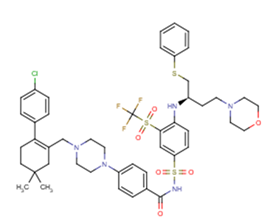store at low temperature
Powder: -20°C for 3 years | In solvent: -80°C for 1 year
Conditionnement : 100mg
Navitoclax (ABT-263) is a Bcl-2 inhibitor that binds to Bcl-xL, Bcl-2, and Bcl-w proteins (Ki<1 nM) with potent and oral activity. Navitoclax has antitumor activity and induces apoptosis.

| Description | Navitoclax (ABT-263) is a Bcl-2 inhibitor that binds to Bcl-xL, Bcl-2, and Bcl-w proteins (Ki<1 nM) with potent and oral activity. Navitoclax has antitumor activity and induces apoptosis. |
| Targets&IC50 | BCL-W:<1 nM (Ki, cell free), BCL-XL:0.4 nM (Ki, cell free), BCL2:<1 nM (Ki, cell free) |
| In vitro | METHODS: Mouse primary B lymphocytes FL5.12/Bcl-xL and FL5.12/Bcl-2 were treated with Navitoclax (0.001-1000 nmol/L) for 48 h. Cell viability was measured using the CellTiter Glo. RESULTS: Navitoclax reversed the protection afforded by overexpression of Bcl-2 or Bcl-xL (EC50 of 60 and 20 nmol/L, respectively). In the presence of IL-3, Navitoclax was ineffective in inducing cell death in the absence of pro-apoptotic stimuli in FL5.12 cells. [1] METHODS: HCC cells PLC/PRF/5, Hep3B, HepG2, and Huh7 were treated with Navitoclax (5 μM) for 18 h, and the expression levels of target proteins were detected by Western Blot. RESULTS: After treatment with Navitoclax, Mcl-1 levels were significantly increased in all HCC cell lines, but Bcl-2 and B cl-xL levels did not change significantly. [2] |
| In vivo | METHODS: To detect anti-tumor activity in vivo, Navitoclax (100 mg/kg in 10% ethanol+30% polyethylene glycol 400+60% Phosal 50 PG) was administered orally to scid mice bearing human SCLC and ALL xenografts once a day for twenty-one days. RESULTS: Oral administration of Navitoclax resulted in tumor regression of SCLC and ALL xenografts in vivo. [1] METHODS: To assay antitumor activity in vivo, Navitoclax (50-100 mg/kg in 10% ethanol+30% polyethylene glycol 400+60% Phosal 50 PG) was administered orally as a single dose to scid mice bearing human SCLC tumor H146. RESULTS: Single-dose Navitoclax-treated H146 tumors showed a high number of dead and dying cells, including a well-vascularized tumor periphery. [3] |
| Kinase Assay | ABT-737 and ABT-263 were synthesized as previously described. The enantiomer and BH3-only peptides were synthesized at Abbott. Binding affinities (Ki or IC50) were determined with competitive fluorescence polarization assays. The following peptide probe/protein pairs were used: f-bad (1 nmol/L) and Bcl-xL (6 nmol/L), f-Bax (1 nmol/L) and Bcl-2 (10 nmol/L), f-Bax (1 nmol/L) and Bcl-w (40 nmol/L), f-Noxa (2 nmol/L) and Mcl-1 (40 nmol/L), and f-Bax (1 nmol/L) and Bcl-2-A1 (15 nmol/L). Binding affinities for Bcl-xL were also determined using a time-resolved fluorescence resonance energy transfer assay. Bcl-xL (1 nmol/L, His tagged) was mixed with 200 nmol/L f-Bak, 1 nmol/L Tb-labeled anti-His antibody, and compound at room temperature for 30 min. Fluorescence was measured on an Envision plate reader using a 340/35 nm excitation filter and 520/525 (f-Bak) and 495/510 nm (Tb-labeled anti-His antibody) emission filters. Dissociation constants (Ki) were determined using Wang's equation [1]. |
| Cell Research | Human tumor cell lines were maintained at 37°C containing 5% CO2. SCLC cell lines were cultured in RPMI 1640 with 10% fetal bovine serum (FBS), 1% sodium pyruvate, 25 mmol/L HEPES, 4.5 g/L glucose, and 1% penicillin/streptomycin. Leukemia and lymphoma cell lines were cultured in RPMI 1640 supplemented with 10% FBS and 1% penicillin/streptomycin. Cells (1 × 10^4–5 × 10^4) were treated for 48 h in 96-well culture plates in a final volume of 100 μL and cytotoxicity was assessed with the CellTiter Glo assay [1]. |
| Animal Research | C.B.-17 scid-bg or C.B.-17 scid mice were implanted with 5 × 10^6 (1 × 10^6 for DoHH2) cells in 0.2 mL 50% Matrigel s.c. into the right flank. Tumor-bearing mice were size matched (~235 mm3; day 0) into treatment and control groups, ear tagged, and monitored individually. Tumor volume was measured two to three times weekly by electronic calipers (volume = length × width2 / 2). Tumor growth inhibition was calculated based on the difference in mean tumor volumes between treated and appropriate vehicle control groups. Partial response (PR) is defined as ≥50% tumor growth inhibition, and complete response (CR) is defined as nonpalpable tumor. All studies used 8 to 10 mice per group. ABT-263 was formulated in 10% ethanol, 30% polyethylene glycol 400, and 60% Phosal 50 PG and administered p.o. The other agents used [rituximab, doxorubicin, cyclophosphamide, vincristine, bortezomib, and prednisone] were administered i.p., p.o., or i.v. and formulated according to the manufacturers' recommendations. For combination studies, ABT-263 was given ~2 h before the other agents, except bortezomib, which was given ~4 h before ABT-263 [1]. |
| Synonyms | ABT-263 |
| Molecular Weight | 974.61 |
| Formula | C47H55ClF3N5O6S3 |
| CAS No. | 923564-51-6 |
store at low temperature
Powder: -20°C for 3 years | In solvent: -80°C for 1 year
Ethanol: < 1 mg/mL (insoluble or slightly soluble)
DMSO: 200 mg/mL (205.21 mM), Sonification is recommended.
H2O: < 1 mg/mL (insoluble or slightly soluble)